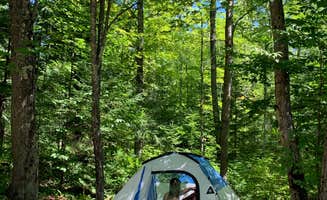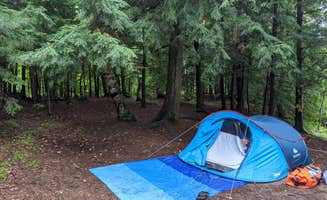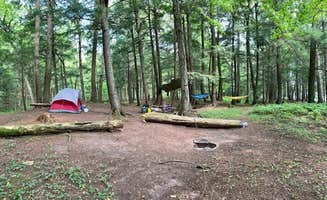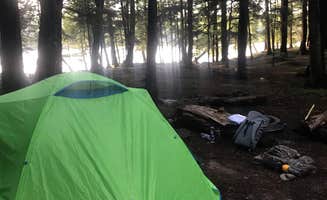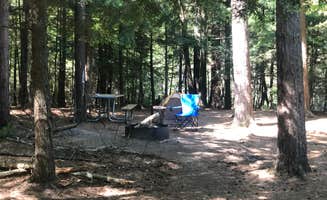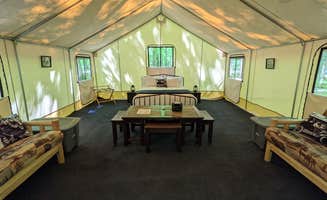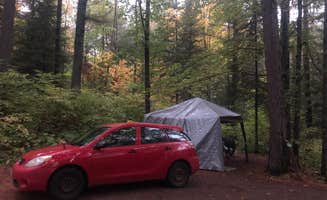Tent camping near Wakefield, Michigan provides access to the Ottawa National Forest's 990,000 acres across Michigan's western Upper Peninsula. The region averages 180-200 inches of snow annually, creating lush summer vegetation and numerous waterfalls for campers to discover. Most backcountry sites range from 1,200-1,800 feet in elevation with variable temperatures even during summer months, requiring campers to pack layers.
What to do
Waterfall exploration: Multiple falls can be accessed from Union River Rustic Outpost Camp where a bridge leads to trails. "Take the right trail and it connects with the Union River mine trail. It's 1 mile long and perfect for relaxing after dinner," notes camper Art S.
Fishing opportunities: At Burned Dam Campground, visitors can fish directly off-site. "Camp is right on a river and the rapids will draw you in. Follow the trail 20 yards and you can find a variety of boulders or logs to perch upon," explains Art S., though he warns about persistent flies.
Canoe camping: The Turtle Flambeau Scenic Waters Area offers boat-accessible camping 45 minutes south of Wakefield. "The Turtle Flambeau Flowage is dubbed the 'Boundary Waters of Wisconsin' and for good reason! The quality of the waters, vast array of channels, islands and camping spots is simply amazing," writes Kim.
What campers like
Privacy between sites: At certain locations like Union River Outpost Camp, site isolation stands out. "Site 1 was so secluded and private. It really felt like nobody else was out here. We had more than enough room to set up and could even have fit additional tents," notes Art S. about the three-site camping area.
Riverside camping: The sound of moving water adds ambiance to many sites. At Burned Dam Campground, campers report hearing "rushing water" from nearby Mex-i-mine Falls. Each site includes "in-ground firepits, picnic table, and a hanging post for trash," according to Kyle K.
Lake access: The Sylvania Wilderness Backcountry Camping area offers paddling-focused experiences. "We did it the easy way, loaded our canoe, crossed the lake to our campsite and set up camp. No portaging with our gear," explains Ann M., who rented equipment from Sylvania Outfitters.
What you should know
Limited site amenities: Most primitive sites require self-sufficiency. Kyle K. reports Burned Dam has "no running water" and "no trash service (pack out all you bring)," though there are basic facilities like fire rings.
Insect activity: Biting insects can be problematic throughout the region. At Burned Dam, one camper noted: "BUGS. this campground was FULL of mosquitos and biting flies. Even with bug spray, the assault was nonstop. Bring a screen-printing popup shelter with you or you will suffer."
Cell service limitations: Reception is unreliable or nonexistent at most wilderness sites. Big Rock Campground and other remote locations require planning ahead. At Union River Outpost, Jenna L. cautions: "Note that there is no cell service here or really nearby. Not an issue if you're prepared for that!"
Tips for camping with families
Book dual sites: For larger family groups at Sylvania Wilderness, consider reserving adjacent sites. Jess R. suggests: "Book both sites for the nights you're staying. At $15 a night per site, it still ends up being a cheap investment for peace and quiet."
Trail-accessible camping: Families appreciate Wabasso Lake Recreation Area with its walk-in sites. "The campgrounds here have a fire ring and table, and plenty of room to set up in. The lake is gorgeous and swimmable," reports Theodora M., though amenities are limited to "a vault toilet and water."
Specialized camping options: For families with members having mobility needs, consider boat-accessible sites. Janet R. describes Stockton Island's "stellar handicapped accessible platform campsite" as "the best and most accessible I've ever seen and would be perfect for a family member of mine with special needs and mobility issues."
Tips from RVers
Small vehicle accessibility: Most wilderness campgrounds limit RV size. Union River Outpost allows small RVs but requires careful navigation. "The gravel drive was uphill so we ended up turning the camper 90 degrees," reports Art S., noting site 1 has "its own 80 foot spur."
Water access planning: No hookups are available at wilderness sites. Art S. advises: "More amenities can be found at the main campground in the state park. We filled up with water there," referring to facilities at Porcupine Mountains Wilderness State Park near Union River Outpost.


